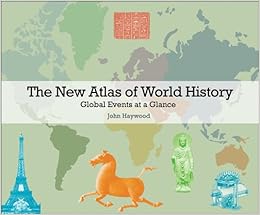
Free Downloads The New Atlas Of World History: Global Events At A Glance

When did humans first inhabit different parts of the world? What was happening in China when Alexander the Great conquered the Persian Empire? What was the global reach of the great religions at the time of the Reformation in Europe? The New Atlas of World History is the first historical atlas to present global history in a series of uniform world maps, allowing at-a-glance comparison between different periods and regions. This stunningly illustrated atlas features 55 specially commissioned full-color maps that cover the whole of human history, from 6 million years ago to today. Accompanying 48 of the maps are detailed illustrated timelines that list important cultures, events, and developments. Maps and timelines also come with concise introductions that summarize notable historical and cultural changes, as well as striking graphic displays that present key data such as the world's five largest cities and total world population for the relevant year. An extensive glossary of peoples, cultures, and nations gives added depth to the maps and timelines. Ideal for quick reference or for an authoritative overview of the human story, The New Atlas of World History provides an unrivaled global perspective on pivotal moments throughout history, from the origins and distribution of early humans to the shifting balance of world power today. Enables at-a-glance comparison between different periods and regions Features 55 stunning full-color maps Includes 48 illustrated timelines, concise text, and an extensive glossary Traces the origins and spread of writing, trade, religion, and much more

Hardcover: 256 pages
Publisher: Princeton University Press (October 30, 2011)
Language: English
ISBN-10: 0691152691
ISBN-13: 978-0691152691
Product Dimensions: 10.8 x 1.4 x 12.6 inches
Shipping Weight: 4.8 pounds (View shipping rates and policies)
Average Customer Review: 4.2 out of 5 stars See all reviews (8 customer reviews)
Best Sellers Rank: #477,981 in Books (See Top 100 in Books) #171 in Books > Reference > Atlases & Maps > World #184 in Books > History > Historical Study & Educational Resources > Historical Maps #1348 in Books > Travel > Reference > Atlases & Maps

I bought this book because I had wanted for a very long time to have a quick reference for world history: i.e., what was happening in some remote parts of the world at the time of, say, Alexander the Great's conquests.This is where this book excels: it shows you the entire world at a certain date.Here is how the book is constructed: there are 49 political maps + 6 thematic maps*, spanning the human history. The first map presents the beginnings and the spreading of humans across the globe (covering the period between 6 million - 100000 years ago), and the atlas takes us all the way to 2010.Each map spreads over two pages and contains a short 'introductory text' in a column to its left. Both the shorelines and the country borders are 'stylized', meaning they are not true 'satellite-like', but simplified curves. There is a coordinate system of sorts, which shows some parallels and meridians, but it is completely useless because these lines are only visible over the ocean, while the continents sit over them and block them out, so you would not be able to geographically locate a place with their help.On the following two pages you can find a timeline of events that led to the political situation presented on the associated map. Each timeline starts in the year following that of the previous map and ends in the year portrayed by the current map. For example: you have a map of the world in 1650, and the next map shows the globe in 1715. The timeline for this second map goes between 1651 and 1715. The events placed on the timeline are color-coded by geographical area, which is useful. There are also inlaid images throughout the timeline, and these are also color-coded (just like you can see on the cover of the atlas). This is a bad idea overall.
The New Atlas of World History: Global Events at a Glance Oral Medicine and Pathology at a Glance (At a Glance (Dentistry)) The Kingfisher Atlas of World History: A pictoral guide to the world's people and events, 10000BCE-present Event Planning: The Ultimate Guide To Successful Meetings, Corporate Events, Fundraising Galas, Conferences, Conventions, Incentives and Other Special Events Risk Management for Meetings and Events (Events Management) The Times Atlas of World History (Hammond Concise Atlas of World History) Atlas of Animal Adventures: A collection of nature's most unmissable events, epic migrations and extraordinary behaviours The New Penguin Atlas of Medieval History: Revised Edition (Hist Atlas) Llewellyn's 2017 Daily Planetary Guide: Complete Astrology At-A-Glance (Llewellyn's Daily Planetary Guide) Hand Embroidery Stitches At A Glance Polish Genealogy Research (Genealogy at a Glance) The Glance: Songs of Soul-Meeting (Compass) Orthodontics at a Glance Periodontology at a Glance Vascular and Endovascular Surgery at a Glance The Visual Factory: Building Participation Through Shared Information (See What's Happening in Your Key Processes--At a Glance, All) Information Dashboard Design: Displaying Data for At-a-Glance Monitoring Facilitation at a Glance!: Your Pocket Guide to Facilitation (Memory Jogger) Conflict at a Glance Bible Time Line: Genesis to Revelation at a Glance



